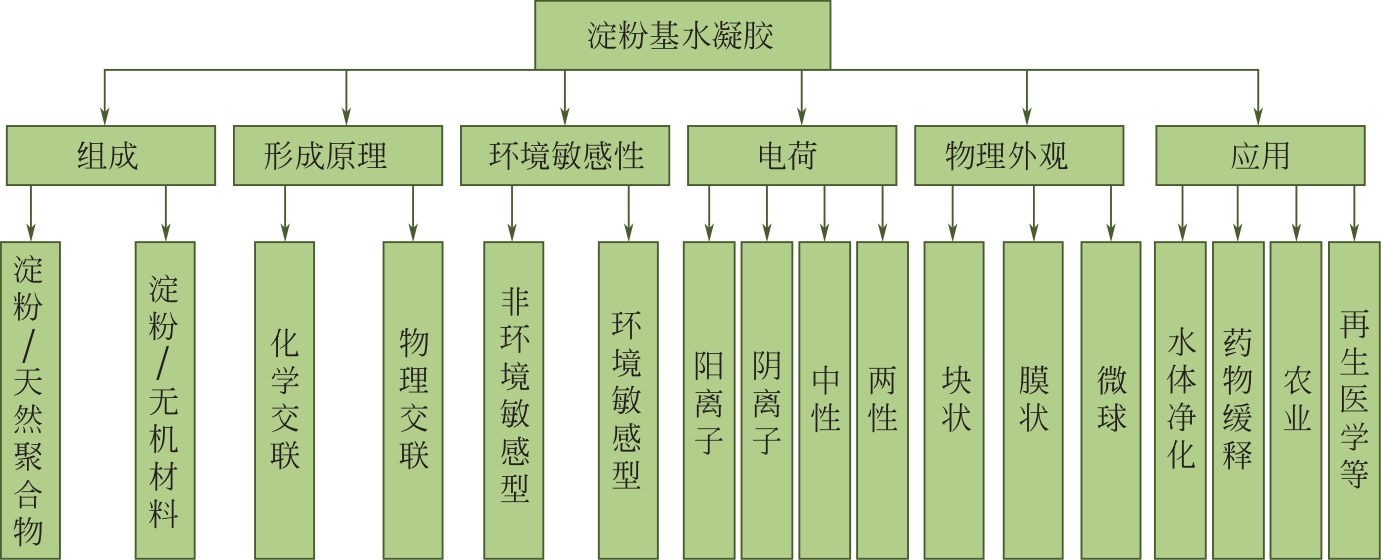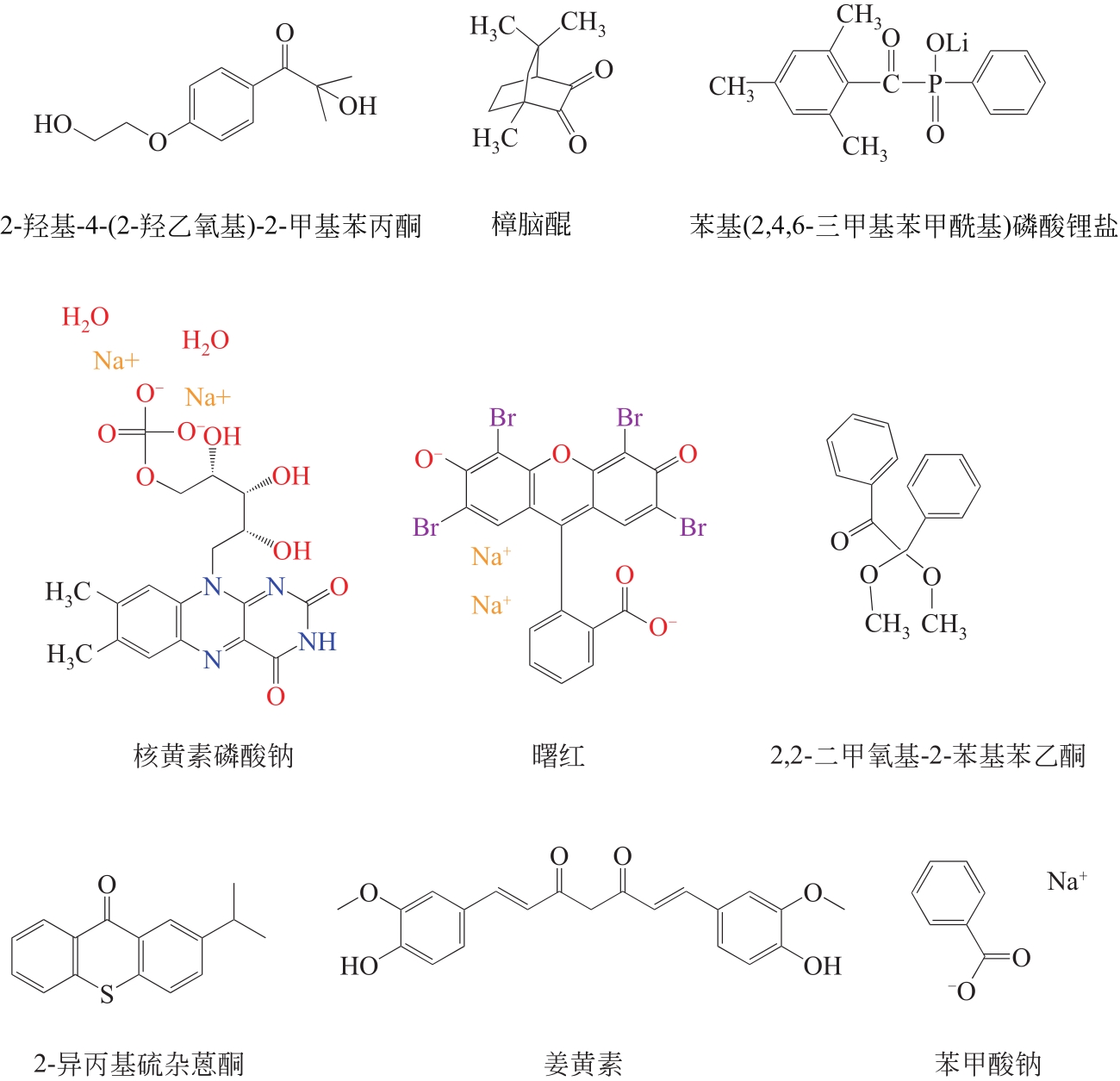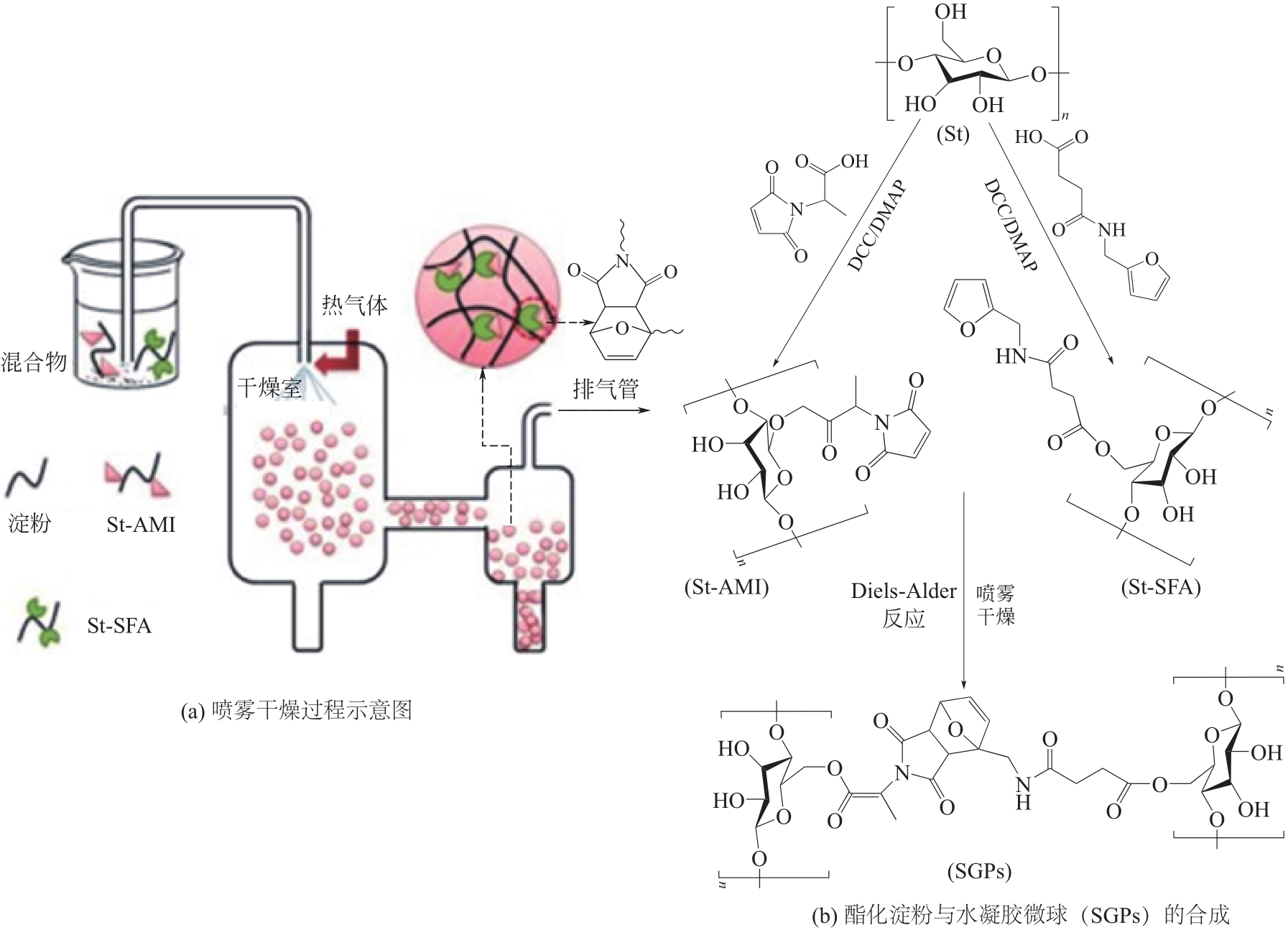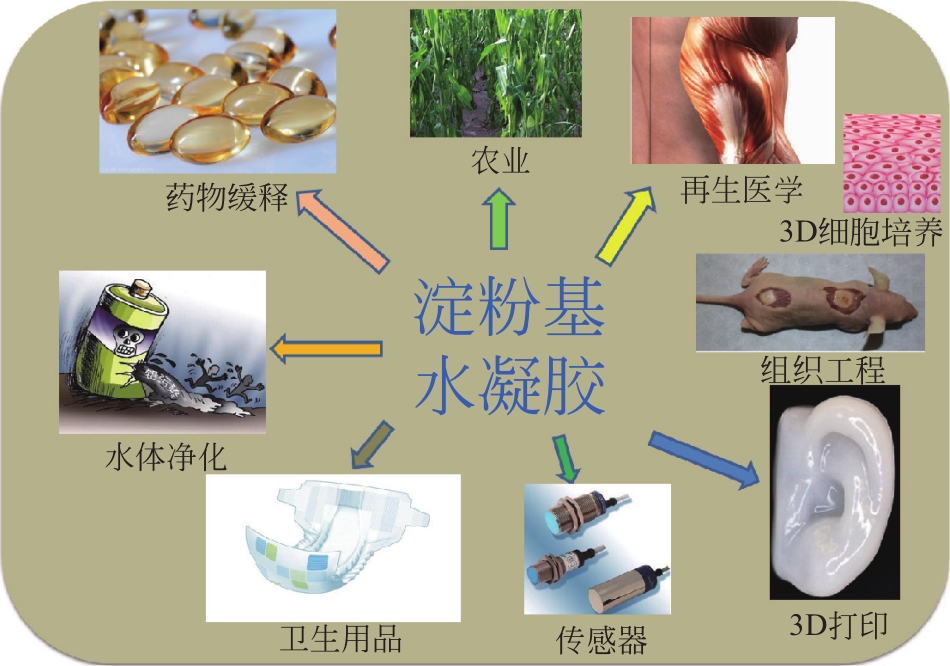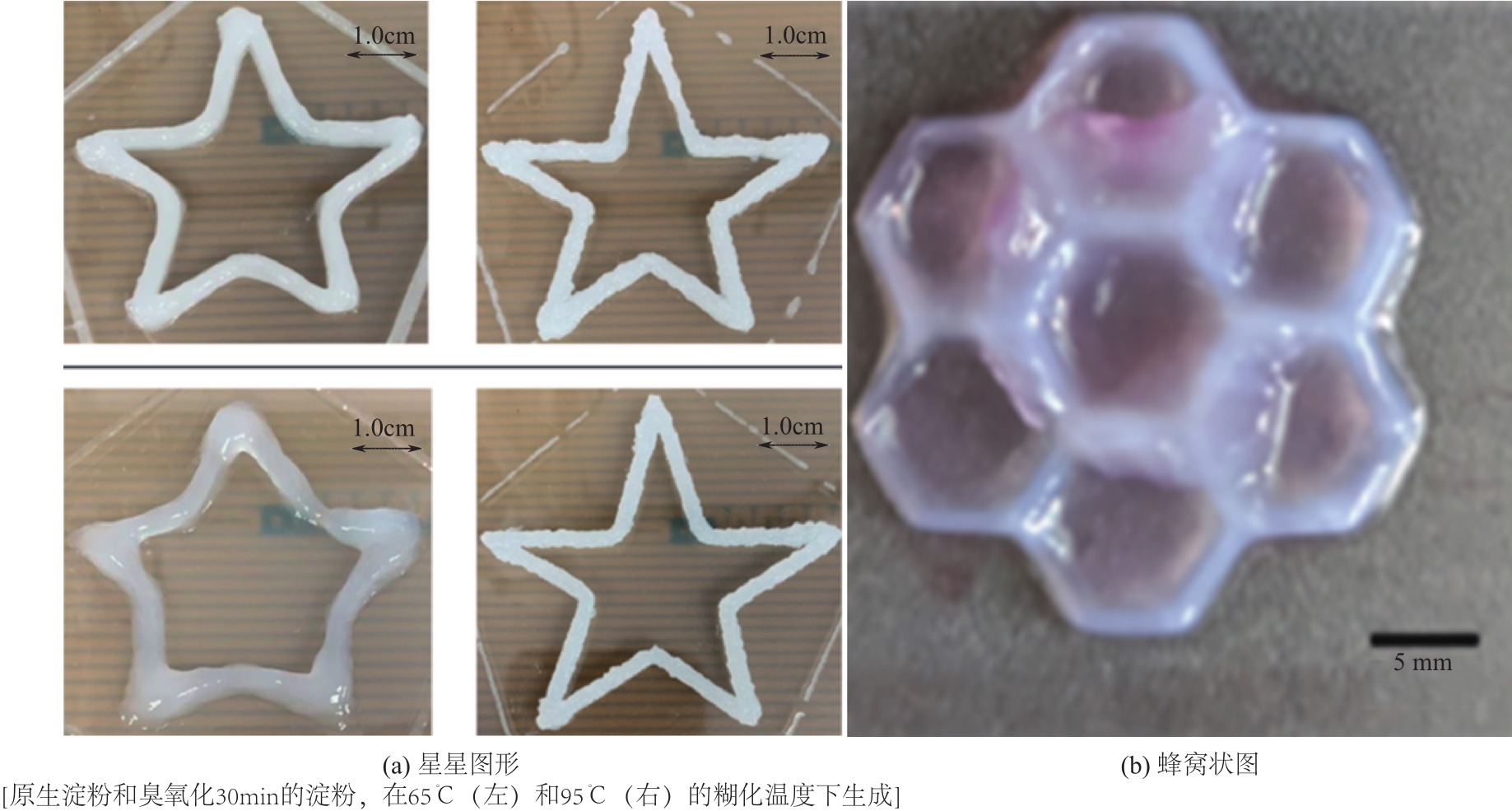化工进展 ›› 2021, Vol. 40 ›› Issue (12): 6738-6751.DOI: 10.16085/j.issn.1000-6613.2021-0099
淀粉基水凝胶的研究进展
刘玉华( ), 魏宏亮(
), 魏宏亮( ), 李松茂, 刘子君, 李维坤, 王刚
), 李松茂, 刘子君, 李维坤, 王刚
- 河南工业大学化学化工学院,河南 郑州 450001
-
收稿日期:2021-01-15修回日期:2021-06-07出版日期:2021-12-05发布日期:2021-12-21 -
通讯作者:魏宏亮 -
作者简介:刘玉华(1995—),女,硕士研究生,研究方向为高分子凝胶材料。E-mail:3207253167@qq.com 。 -
基金资助:国家自然科学基金(U1904171);河南省科技厅科技攻关(202102310008);河南省高等学校重点科研项目(20A430008);河南工业大学校基金(HAUTZX202003)
Research progress of starch - based hydrogels
LIU Yuhua( ), WEI Hongliang(
), WEI Hongliang( ), LI Songmao, LIU Zijun, LI Weikun, WANG Gang
), LI Songmao, LIU Zijun, LI Weikun, WANG Gang
- School of Chemistry and Chemical Engineering, Henan University of Technology, Zhengzhou 450001, Henan, China
-
Received:2021-01-15Revised:2021-06-07Online:2021-12-05Published:2021-12-21 -
Contact:WEI Hongliang
摘要:
淀粉是一种可再生的天然高分子,具有生物相容性好、可生物降解、无毒等优点,而水凝胶是具有吸水、保水性能的亲水聚合物网络。本文对近5年来淀粉基水凝胶的研究成果进行了归纳总结,以期为科研工作者提供淀粉基水凝胶的最新研究进展。文章分为如下部分:第一部分介绍了淀粉基水凝胶的研究背景;第二部分从淀粉基水凝胶的组成、形成原理、环境响应性等方面进行归纳总结;第三部分重点介绍了淀粉基水凝胶在水体净化、药物缓释、3D打印、农业和再生医学方面的应用。由此可知,目前淀粉基水凝胶在传感器、光电材料等方面的应用研究较少,同时其性能还不能够完全满足实际需求,因此科研工作者需进一步研究淀粉基水凝胶的结构与性能相互作用规律,完善淀粉基水凝胶的制备策略,拓展淀粉基水凝胶的应用范围,同时快速将其商品化及市场化,以产生巨大的经济效益与环境效益。
中图分类号:
引用本文
刘玉华, 魏宏亮, 李松茂, 刘子君, 李维坤, 王刚. 淀粉基水凝胶的研究进展[J]. 化工进展, 2021, 40(12): 6738-6751.
LIU Yuhua, WEI Hongliang, LI Songmao, LIU Zijun, LI Weikun, WANG Gang. Research progress of starch - based hydrogels[J]. Chemical Industry and Engineering Progress, 2021, 40(12): 6738-6751.
| 淀粉类型 | 其他材料 | 制备方法 | 应用 | 主要结论 | 参考文献 |
|---|---|---|---|---|---|
| 可溶淀粉 | 氧化纤维素纳米纤维 | 静电作用 | 用作流变改性剂 | 纤维素的加入提高水凝胶的刚度和黏度 | [ |
| 玉米淀粉 | 纤维素纳米晶须 | 辐射交联 | 药物缓释 | 加入纳米晶须后,药物释放时间延长了2.9倍 | [ |
| 原淀粉 | 纤维素纳米纤维/丙烯酸 | 原子转移自由基聚合 | 吸附Cu2+ | 水凝胶最大吸附量为957mg/g | [ |
| 原淀粉 | 磁功能化纤维素纳米晶(MCNCs) | 酶催化 | 吸附阳离子染料 | 加入MCNCs的水凝胶对结晶紫、亚甲基蓝的最大吸附量分别为2500.0mg/g、1428.6mg/g,且表现出良好的可重复性 | [ |
| 原淀粉 | 羧甲基纤维素 | 物理交联 | 药物缓释 | 在pH为6.8和7.4的磷酸盐缓冲液中,水凝胶在12h的药物释放量最高 | [ |
| 玉米淀粉 | 壳聚糖 | 自由基聚合 | 吸附亚甲基蓝 | 淀粉/壳聚糖比例为50/50时,溶胀度为120%左右,在5h达到平衡,且对染料吸附效果最好 | [ |
| 玉米淀粉 | 化学改性天然炭纳米颗粒 | 物理、化学交联 | 高吸水性材料 | 化学改性的碳纳米材料水凝胶的吸水量是纯水凝胶的2倍,为389.9g/g,且保水性为23.1%,是纯水凝胶的3倍 | [ |
| 原淀粉 | 碳化大豆荚 | 交联剂交联 | 吸附萘普生药物和Cr(Ⅵ) | 最高溶胀度为500%,对Cr(Ⅵ)和萘普生药物的去除率分别为96.45%、78% | [ |
| 玉米淀粉 | 氧化石墨烯 | 一步法 | 染料吸附 | 在石墨烯薄片之间掺入淀粉制备的水凝胶,吸附的染料比石墨烯水凝胶多75% | [ |
| 马铃薯淀粉 | 埃洛石纳米管 | 自由基聚合 | 肥料缓释 | 水凝胶溶胀度可达5390%,对尿素缓释放在12h后达到84.6% | [ |
| 双醛淀粉 | N-琥珀酰壳聚糖(SCS) | 席夫碱反应 | 药物缓释 | 姜黄素释放在2天达到平衡,且SCS的含量显著提高了人牙龈成纤维细胞黏附在水凝胶表面的数量,使水凝胶在组织工程软骨修复等方面有应用潜力 | [ |
| 醛基淀粉 | 氨基羧甲基壳聚糖 | 席夫碱反应 | 用于软组织黏合剂、止血等 | 通过改变醛和氨基的含量,可以调节水凝胶的成胶时间、溶胀率和机械拉伸性能,其最高拉伸强度可达到(42.73±1.18)kPa | [ |
| 双醛淀粉 | 明胶 | 湿法纺丝法 | 生物医学 | 海藻酸盐水凝胶纤维和海藻酸盐/明胶混合水凝胶纤维的线密度值由5.79dtex降至4.14dtex,证明明胶的过量加入会破坏藻酸盐/明胶混合水凝胶纤维的力学性能 | [ |
| 氧化淀粉 | CuO | 原位自由基聚合 | 药物缓释 | 该水凝胶在pH为2.1时的溶胀率低于pH为7.4时的溶胀率,其控释性均随纳米氧化铜含量的增加而增加 | [ |
| 氧化淀粉 | ZnO | 交联剂交联 | 抑菌性能 | 该水凝胶在pH为7时水溶液的溶胀度最大,大约为2700%,用于抑菌时细菌零增长,抑菌圈达到11mm | [ |
戊烯酸 功能化淀粉 | 明胶 | 交联剂交联 | 组织再生 | 交联最少的明胶水凝胶具有最高的成脂分化程度,其取代度为31%,储存模量为14kPa | [ |
呋喃功能化 淀粉 | 石墨烯 | Diels-Alder反应 | 生物医学 | 加入石墨烯使纳米复合水凝胶的力学性能、抗菌活性得到了显著提高,电导率从1.23×10-4S/m增加到1.16×10-3S/m | [ |
| 肉豆蔻酸功能化淀粉 | 氧化石墨烯 | 主客体相互作用 | 水体净化 | 制备的纳米复合水凝胶具有明显的、相互连通的三维多孔网络,孔径在亚微米到几微米之间 | [ |
| 可溶淀粉 | 氧化石墨烯 | 辐射交联 | 智能电子设备胶黏剂 | 具有快速自动自愈能力,离子电导率大约为10.5mS/dm | [ |
| 淀粉纳米晶体(SNCs) | 明胶 | 物理交联 | 细胞培养 | 添加0.5%的SNCs压缩模量从(2.0±0.1)kPa增加至(3.1±0.1)kPa,溶胀率变化不大 | [ |
| 可压性淀粉 | 埃洛石 | 偶联法 | 药物缓释 | 药物装入埃洛石腔内,而不是将药物嵌入水凝胶网络,可以有效地抑制初始的爆发性释放,且在30min达到平衡 | [ |
表1 淀粉基水凝胶的组成
| 淀粉类型 | 其他材料 | 制备方法 | 应用 | 主要结论 | 参考文献 |
|---|---|---|---|---|---|
| 可溶淀粉 | 氧化纤维素纳米纤维 | 静电作用 | 用作流变改性剂 | 纤维素的加入提高水凝胶的刚度和黏度 | [ |
| 玉米淀粉 | 纤维素纳米晶须 | 辐射交联 | 药物缓释 | 加入纳米晶须后,药物释放时间延长了2.9倍 | [ |
| 原淀粉 | 纤维素纳米纤维/丙烯酸 | 原子转移自由基聚合 | 吸附Cu2+ | 水凝胶最大吸附量为957mg/g | [ |
| 原淀粉 | 磁功能化纤维素纳米晶(MCNCs) | 酶催化 | 吸附阳离子染料 | 加入MCNCs的水凝胶对结晶紫、亚甲基蓝的最大吸附量分别为2500.0mg/g、1428.6mg/g,且表现出良好的可重复性 | [ |
| 原淀粉 | 羧甲基纤维素 | 物理交联 | 药物缓释 | 在pH为6.8和7.4的磷酸盐缓冲液中,水凝胶在12h的药物释放量最高 | [ |
| 玉米淀粉 | 壳聚糖 | 自由基聚合 | 吸附亚甲基蓝 | 淀粉/壳聚糖比例为50/50时,溶胀度为120%左右,在5h达到平衡,且对染料吸附效果最好 | [ |
| 玉米淀粉 | 化学改性天然炭纳米颗粒 | 物理、化学交联 | 高吸水性材料 | 化学改性的碳纳米材料水凝胶的吸水量是纯水凝胶的2倍,为389.9g/g,且保水性为23.1%,是纯水凝胶的3倍 | [ |
| 原淀粉 | 碳化大豆荚 | 交联剂交联 | 吸附萘普生药物和Cr(Ⅵ) | 最高溶胀度为500%,对Cr(Ⅵ)和萘普生药物的去除率分别为96.45%、78% | [ |
| 玉米淀粉 | 氧化石墨烯 | 一步法 | 染料吸附 | 在石墨烯薄片之间掺入淀粉制备的水凝胶,吸附的染料比石墨烯水凝胶多75% | [ |
| 马铃薯淀粉 | 埃洛石纳米管 | 自由基聚合 | 肥料缓释 | 水凝胶溶胀度可达5390%,对尿素缓释放在12h后达到84.6% | [ |
| 双醛淀粉 | N-琥珀酰壳聚糖(SCS) | 席夫碱反应 | 药物缓释 | 姜黄素释放在2天达到平衡,且SCS的含量显著提高了人牙龈成纤维细胞黏附在水凝胶表面的数量,使水凝胶在组织工程软骨修复等方面有应用潜力 | [ |
| 醛基淀粉 | 氨基羧甲基壳聚糖 | 席夫碱反应 | 用于软组织黏合剂、止血等 | 通过改变醛和氨基的含量,可以调节水凝胶的成胶时间、溶胀率和机械拉伸性能,其最高拉伸强度可达到(42.73±1.18)kPa | [ |
| 双醛淀粉 | 明胶 | 湿法纺丝法 | 生物医学 | 海藻酸盐水凝胶纤维和海藻酸盐/明胶混合水凝胶纤维的线密度值由5.79dtex降至4.14dtex,证明明胶的过量加入会破坏藻酸盐/明胶混合水凝胶纤维的力学性能 | [ |
| 氧化淀粉 | CuO | 原位自由基聚合 | 药物缓释 | 该水凝胶在pH为2.1时的溶胀率低于pH为7.4时的溶胀率,其控释性均随纳米氧化铜含量的增加而增加 | [ |
| 氧化淀粉 | ZnO | 交联剂交联 | 抑菌性能 | 该水凝胶在pH为7时水溶液的溶胀度最大,大约为2700%,用于抑菌时细菌零增长,抑菌圈达到11mm | [ |
戊烯酸 功能化淀粉 | 明胶 | 交联剂交联 | 组织再生 | 交联最少的明胶水凝胶具有最高的成脂分化程度,其取代度为31%,储存模量为14kPa | [ |
呋喃功能化 淀粉 | 石墨烯 | Diels-Alder反应 | 生物医学 | 加入石墨烯使纳米复合水凝胶的力学性能、抗菌活性得到了显著提高,电导率从1.23×10-4S/m增加到1.16×10-3S/m | [ |
| 肉豆蔻酸功能化淀粉 | 氧化石墨烯 | 主客体相互作用 | 水体净化 | 制备的纳米复合水凝胶具有明显的、相互连通的三维多孔网络,孔径在亚微米到几微米之间 | [ |
| 可溶淀粉 | 氧化石墨烯 | 辐射交联 | 智能电子设备胶黏剂 | 具有快速自动自愈能力,离子电导率大约为10.5mS/dm | [ |
| 淀粉纳米晶体(SNCs) | 明胶 | 物理交联 | 细胞培养 | 添加0.5%的SNCs压缩模量从(2.0±0.1)kPa增加至(3.1±0.1)kPa,溶胀率变化不大 | [ |
| 可压性淀粉 | 埃洛石 | 偶联法 | 药物缓释 | 药物装入埃洛石腔内,而不是将药物嵌入水凝胶网络,可以有效地抑制初始的爆发性释放,且在30min达到平衡 | [ |
| 应用领域 | 制备方法 | 凝胶组成 | 污染物 | 比表面积 /m2·g-1 | 孔洞容量 /cm3·g-1 | 最大吸附量 /mg·g-1 | 参考 文献 |
|---|---|---|---|---|---|---|---|
| 染料吸附 | 电旋法 | 淀粉/聚乙烯醇 | 亚甲基蓝 | 24.72 | 0.0421 | 400 | [ |
| 原子转移自由基聚合 | 木薯淀粉/丙烯酰胺 | 亚甲基蓝 | — | — | 1917 | [ | |
| 酶催化 | 原淀粉/MCNCs | 结晶紫、亚甲基蓝 | — | — | 2500.0、1428.6 | [ | |
| 一步法 | 玉米淀粉/多孔石墨烯 | 核壳荧光 | 45 | 0.03 | 1.1069 | [ | |
| 金属离子 | 交联剂交联 | 原淀粉/生物炭 | Cr(Ⅵ) | 226.94 | 9.88 | 420.13 | [ |
| 交联剂交联 | 2-羟基-3-异丙氧基丙基淀粉/海藻酸钠 | — | — | [ | |||
| 辐射交联 | 木薯淀粉/丙烯酸 | — | — | [ | |||
| 原子转移自由基聚合 | 原淀粉/纤维素/丙烯酸 | — | — | [ |
表2 淀粉基水凝胶在水体净化方面的应用
| 应用领域 | 制备方法 | 凝胶组成 | 污染物 | 比表面积 /m2·g-1 | 孔洞容量 /cm3·g-1 | 最大吸附量 /mg·g-1 | 参考 文献 |
|---|---|---|---|---|---|---|---|
| 染料吸附 | 电旋法 | 淀粉/聚乙烯醇 | 亚甲基蓝 | 24.72 | 0.0421 | 400 | [ |
| 原子转移自由基聚合 | 木薯淀粉/丙烯酰胺 | 亚甲基蓝 | — | — | 1917 | [ | |
| 酶催化 | 原淀粉/MCNCs | 结晶紫、亚甲基蓝 | — | — | 2500.0、1428.6 | [ | |
| 一步法 | 玉米淀粉/多孔石墨烯 | 核壳荧光 | 45 | 0.03 | 1.1069 | [ | |
| 金属离子 | 交联剂交联 | 原淀粉/生物炭 | Cr(Ⅵ) | 226.94 | 9.88 | 420.13 | [ |
| 交联剂交联 | 2-羟基-3-异丙氧基丙基淀粉/海藻酸钠 | — | — | [ | |||
| 辐射交联 | 木薯淀粉/丙烯酸 | — | — | [ | |||
| 原子转移自由基聚合 | 原淀粉/纤维素/丙烯酸 | — | — | [ |
| 1 | PANDISELVAM R, MANIKANTAN M R, DIVYA V, et al. Ozone: an advanced oxidation technology for starch modification[J]. Ozone: Science & Engineering, 2019, 41(6): 491-507. |
| 2 | EL-HOSHOUDY A N, DESOUKY S M. Synthesis and evaluation of acryloylated starch-g-poly (acrylamide/vinylmethacrylate/1-vinyl-2-pyrrolidone) crosslinked terpolymer functionalized by dimethylphenylvinylsilane derivative as a novel polymer-flooding agent[J]. International Journal of Biological Macromolecules, 2018, 116: 434-442. |
| 3 | HOSSAIN K M Z, CALABRESE V, SILVA M A DA, et al. Cationic surfactants as a non-covalent linker for oxidised cellulose nanofibrils and starch-based hydrogels[J]. Carbohydrate Polymers, 2020, 233: 115816. |
| 4 | ZHU F. Encapsulation and delivery of food ingredients using starch based systems[J]. Food Chemistry, 2017, 229: 542-552. |
| 5 | DENG Z X, GUO Y, ZHAO X, et al. Multifunctional stimuli-responsive hydrogels with self-healing, high conductivity, and rapid recovery through host-guest interactions[J]. Chemistry of Materials, 2018, 30(5): 1729-1742. |
| 6 | KHAN S, AKHTAR N, MINHAS M U, et al. pH/Thermo-dual responsive tunable in situ cross-linkable depot injectable hydrogels based on poly(N-isopropylacrylamide)/carboxymethyl chitosan with potential of controlled localized and systemic drug delivery[J]. AAPS PharmSciTech, 2019, 20(3): 119. |
| 7 | WANG Y, ZHAO F, Wang J, et al. Tungsten-doped VO2/starch derivative hybrid nanothermochromic hydrogel for smart window[J]. Nanomaterials, 2019, 9(7): 970. |
| 8 | WEI H L, YANG X Q, CHU H J, et al. Facile and green preparation of thermal and pH sensitive hydrogel microspheres based on spray drying and the diels-alder reaction[J]. Polymer Engineering and Science, 2019, 59(10): 1999-2007. |
| 9 | WANG Y W, CHEN L Y, AN F P, et al. A novel polysaccharide gel bead enabled oral enzyme delivery with sustained release in small intestine[J]. Food Hydrocolloids, 2018, 84: 68-74. |
| 10 | CHEN X, ZHAN Z X, LIU Q M, et al. Modeling the response characteristics of photo-sensitive hydrogel electrolytes in Hofmeister salt solution for the development of smart energy storage devices[J]. Sustainable Energy & Fuels, 2020, 4(12): 6112-6124. |
| 11 | MAURICIO M R, COSTA P G DA, HARAGUCHI S K, et al. Synthesis of a microhydrogel composite from cellulose nanowhiskers and starch for drug delivery[J]. Carbohydrate Polymers, 2015, 115: 715-722. |
| 12 | BAGHBADORANI N B, BEHZAD T, ETESAMI N, et al. Removal of Cu2+ ions by cellulose nanofibers-assisted starch-g-poly(acrylic acid) superadsorbent hydrogels[J]. Composites Part B: Engineering, 2019, 176: 107084. |
| 13 | MOHARRAMI P, MOTAMRDI E. Application of cellulose nanocrystals prepared from agricultural wastes for synthesis of starch-based hydrogel nanocomposites: efficient and selective nanoadsorbent for removal of cationic dyes from water[J]. Bioresource Technology, 2020, 313: 123661. |
| 14 | GHOLAMALI I, YADOLLAHI M. Doxorubicin-loaded carboxymethyl cellulose/starch/ZnO nanocomposite hydrogel beads as an anticancer drug carrier agent[J]. International Journal of Biological Macromolecules, 2020, 160: 724-735. |
| 15 | PEIDAYESH H, AHMADI Z, KHONAKDAR H A, et al. Baked hydrogel from corn starch and chitosan blends cross-linked by citric acid: preparation and properties[J]. Polymers for Advanced Technologies, 2020, 31(6): 1256-1269. |
| 16 | MOTAMEDI E, MOTESHAREZEDEH B, SHIRINFEKR A, et al. Synthesis and swelling behavior of environmentally friendly starch-based superabsorbent hydrogels reinforced with natural char nano/micro particles[J]. Journal of Environmental Chemical Engineering, 2020, 8(1): 103583. |
| 17 | MOHAMED A K, MAHMOUD M E. Nanoscale pisum sativum pods biochar encapsulated starch hydrogel: a novel nanosorbent for efficient chromium (Ⅵ) ions and naproxen drug removal[J]. Bioresource Technology, 2020, 308: 123263. |
| 18 | SUBHI A A, KIAMAHALLEH M V, FIROUZI M, et al. Self-assembled graphene hydrogel composites for selective dye removal[J]. Advanced Sustainable Systems, 2020, 4(9): 2000055. |
| 19 | WEI H L, WANG H, CHU H J, et al. Preparation and characterization of slow-release and water-retention fertilizer based on starch and halloysite[J]. International Journal of Biological Macromolecules, 2019, 133: 1210-1218. |
| 20 | KAMOUN E A. N-succinyl chitosan-dialdehyde starch hybrid hydrogels for biomedical applications[J]. Journal of Advanced Research, 2016, 7(1): 69-77. |
| 21 | LIU J, LI J, YU F, et al. In situ forming hydrogel of natural polysaccharides through Schiff base reaction for soft tissue adhesive and hemostasis[J]. International Journal of Biological Macromolecules, 2020, 147: 653-666. |
| 22 | WANG Q Q, LIU Y, ZHANG C J, et al. Alginate/gelatin blended hydrogel fibers cross-linked by Ca2+ and oxidized starch: preparation and properties[J]. Materials Science & Engineering C: Materials for Biological Applications, 2019, 99: 1469-1476. |
| 23 | GHOLAMALI I, HOSSEINI S N, ALIPOUR E, et al. Preparation and characterization of oxidized starch/CuO nanocomposite hydrogels applicable in a drug delivery system[J]. Starch-Stärke, 2019, 71(3/4): 1800118. |
| 24 | NAMAZI H, HASANI M, YADOLLAHI M. Antibacterial oxidized starch/ZnO nanocomposite hydrogel: synthesis and evaluation of its swelling behaviours in various pHs and salt solutions[J]. International Journal of Biological Macromolecules, 2019, 126: 578-584. |
| 25 | NIEUWENHOVE I V, SALAMON A, ADAM S, et al. Gelatin- and starch-based hydrogels. part B: in vitro mesenchymal stem cell behavior on the hydrogels[J]. Carbohydrate Polymers, 2017, 161: 295-305. |
| 26 | GONZÁLEZ K, GARCÍA-ASTRAIN C, SANTAMARIA-ECHART A, et al. Starch/graphene hydrogels via click chemistry with relevant electrical and antibacterial properties[J]. Carbohydrate Polymers, 2018, 202: 372-381. |
| 27 | PARSAMANESH M, TEHRANI A D, MANSOURPANAH Y. Supramolecular hydrogel based on cyclodextrin modified GO as a potent natural organic matter absorbent[J]. European Polymer Journal, 2017, 92: 126-136. |
| 28 | WANG Y M, HUANG F R, CHEN X B, et al. Stretchable, conductive, and self-healing hydrogel with super metal adhesion[J]. Chemistry of Materials, 2018, 30(13): 4289-4297. |
| 29 | PILUSO S, LABET M, ZHOU C, et al. Engineered three-dimensional microenvironments with starch nanocrystals as cell-instructive materials[J]. Biomacromolecules, 2019, 20(10): 3819-3830. |
| 30 | LIU F, BAI L B, ZHANG H L, et al. Smart H2O2-responsive drug delivery system made by halloysite nanotubes and carbohydrate polymers[J]. ACS Applied Materials & Interfaces, 2017, 9(37): 31626-31633. |
| 31 | CHA C, SHIN S R, GAO X G, et al. Controlling mechanical properties of cell-laden hydrogels by covalent incorporation of graphene oxide[J]. Small, 2014, 10(3): 514-523. |
| 32 | CUI W, JI J, CAI Y F, et al. Robust, anti-fatigue, and self-healing graphene oxide/hydrophobically associated composite hydrogels and their use as recyclable adsorbents for dye wastewater treatment[J]. Journal of Materials Chemistry A, 2015, 3(33): 17445-17458. |
| 33 | SABBAGH N, AkBARI A, ARSALANI N, et al. Halloysite-based hybrid bionanocomposite hydrogels as potential drug delivery systems[J]. Applied Clay Science, 2017, 148: 48-55. |
| 34 | YU C, TANG X Z, LIU S W, et al. Laponite crosslinked starch/polyvinyl alcohol hydrogels by freezing/thawing process and studying their cadmium ion absorption[J]. International Journal of Biological Macromolecules, 2018: 117: 1-6. |
| 35 | REN J Y, XUAN H Y, GE L Q. Double network self-healing chitosan/dialdehyde starch-polyvinyl alcohol film for gas separation[J]. Applied Surface Science, 2019, 469: 213-219. |
| 36 | ALMEIDA F S, SATO A C K. Structure of gellan gum-hydrolyzed collagen particles: effect of starch addition and coating layer[J]. Food Research International, 2019, 121: 394-403. |
| 37 | KOOPMANS C, RITTER H. Formation of physical hydrogels via host-guest interactions of beta-cyclodextrin polymers and copolymers bearing adamantyl groups[J]. Macromolecules, 2008, 41(20): 7418-7422. |
| 38 | LI J, JI C D, LÜ B Z, et al. Dually crosslinked supramolecular hydrogel for cancer biomarker sensing[J]. ACS Applied Materials & Interfaces, 2020, 12(33): 36873-36881. |
| 39 | WANG Y F, LIN M H, DAI W Q, et al. Enhancement of Fe(Ⅲ) to electro-response of starch hydrogel[J]. Colloid and Polymer Science, 2020, 298(11): 1533-1541. |
| 40 | ASHRI A, AMALINA N, KAMIL A, et al. Modified Dioscoreahispida starch-based hydrogels and their in-vitro cytotoxicity study on small intestine cell line (FHS-74 Int)[J]. International Journal of Biological Macromolecules, 2018, 107: 2412-2421. |
| 41 | OLAD A, DOUSTDAR F, GHAREKHANI H. Starch-based semi-IPN hydrogel nanocomposite integrated with clinoptilolite: preparation and swelling kinetic study[J]. Carbohydrate Polymers, 2018, 200: 516-528. |
| 42 | CHAUDHURI S D, MANDAL A, DEY A, et al. Tuning the swelling and rheological attributes of bentonite clay modified starch grafted polyacrylic acid based hydrogel[J]. Applied Clay Science, 2020, 185: 105405. |
| 43 | ZAIN A H M, WAHAB M K A, ISMAIL H. Solid-state photo-cross-linking of cassava starch: improvement properties of thermoplastic starch[J]. Polymer Bulletin, 2018, 75(8): 3341-3356. |
| 44 | NOÈ C, TONDA-TURO C, CHIAPPONE A, et al. Light processable starch hydrogels[J]. Polymers, 2020, 12(6): 1359. |
| 45 | SENNA M M, MOSTAFA A E B, MAHDY S R, et al. Characterization of blend hydrogels based on plasticized starch/cellulose acetate/carboxymethyl cellulose synthesized by electron beam irradiation[J]. Nuclear Instruments and Methods in Physics Research Section B: Beam Interactions with Materials and Atoms, 2016, 386: 22-29. |
| 46 | FEKETE T, BORSA J, TAKÁCS E, et al. Synthesis of carboxymethylcellulose/starch superabsorbent hydrogels by gamma-irradiation[J]. Chemistry Central Journal, 2017, 11(1): 46. |
| 47 | MOHAMED A K, MAHMOUD M E. Encapsulation of starch hydrogel and doping nanomagnetite onto metal-organic frameworks for efficient removal of fluvastatin antibiotic from water[J]. Carbohydrate Polymers, 2020, 245: 116438. |
| 48 | LI Y L, TAN Y, XU K, et al. A biodegradable starch hydrogel synthesized via thiol-ene click chemistry[J]. Polymer Degradation and Stability, 2017, 137: 75-82. |
| 49 | LI X M, WU Z Z, ZHANG B, et al. Fabrication of chitosan hydrochloride and carboxymethyl starch complex nanogels as potential delivery vehicles for curcumin[J]. Food Chemistry, 2019, 293: 197-203. |
| 50 | NOH G J, LIM S A, LEE E S. pH-responsive squeezing polysaccharidic nanogels for efficient docetaxel delivery[J]. Polymers for Advanced Technologies, 2019, 30(8): 2067-2074. |
| 51 | WEI H L, LI W K, CHEN H L, et al. Simultaneous Diels-Alder click reaction and starch hydrogel microsphere production via spray drying[J]. Carbohydrate Polymers, 2020, 241: 116351. |
| 52 | MORADI E, EBRAHIMZADEH H, MEHRANI Z, et al. The efficient removal of methylene blue from water samples using three-dimensional poly(vinyl alcohol)/starch nanofiber membrane as a green nanosorbent[J]. Environmental Science and Pollution Research, 2019, 26(34): 35071-35081. |
| 53 | KUCHAIYAPHUM P, CHOTICHAYAPONG C, BUTWONG N, et al. Silk fibroin/poly(vinyl alcohol) hydrogel cross-linked with dialdehyde starch for wound dressing applications[J]. Macromolecular Research, 2020, 28(9): 844-850. |
| 54 | QIN Y, WANG J P, QIU C, et al. A dual cross-linked strategy to construct moldable hydrogels with high stretchability, good self-recovery, and self-healing capability[J]. Journal of Agricultural and Food Chemistry, 2019, 67(14): 3966-3980 |
| 55 | 李玉芳, 刘君瑜, 王翔宇, 等. 智能水凝胶药物控释系统的研究进展[J]. 口腔医学, 2020, 40(10): 951-954. |
| LI Yufang,LIU Junyu,WANG Xiangyu, et al. Research progress of intelligent hydrogel drug controlled release system[J]. Stomatology, 2020, 40(10): 951-954. | |
| 56 | 刘展晴. 半互穿网络淀粉水凝胶的制备及溶胀性研究[J]. 化学研究与应用, 2019, 31(3): 516-521. |
| LIU Zhanqing. Preparation and swelling properties of semi-interpenetrating network starch hydrogel[J]. Chemical Research and Application, 2019, 31(3): 516-521. | |
| 57 | EKENSEAIR A K, BOERE K W M, TZOUANAS S N, et al. Synthesis and characterization of thermally and chemically gelling injectable hydrogels for tissue engineering[J]. Biomacromolecules, 2012, 13(6): 1908-1915. |
| 58 | HAQ M A, SU Y L, WANG D J. Mechanical properties of PNIPAM based hydrogels: a review[J]. Materials Science & Engineering C: Materials for Biological Applications, 2017, 70: 842-855. |
| 59 | JENA D K, SAHOO P K. New strategies for the construction of eggshell powder reinforced starch based fire hazard suppression biomaterials with tailorable thermal, mechanical and oxygen barrier properties[J]. International Journal of Biological Macromolecules, 2019, 140: 496-504. |
| 60 | FENG J C, DOU J P, ZHANG Y Z, et al. Thermosensitive hydrogel for encapsulation and controlled release of biocontrol agents to prevent peanut aflatoxin contamination[J]. Polymers, 2020, 12(3): 547. |
| 61 | BANERJEE S L, SWIFT T, HOSKINS R, et al. A muscle mimetic polyelectrolyte-nanoclay organic-inorganic hybrid hydrogel: its self-healing, shape-memory and actuation properties[J]. Journal of Materials Chemistry B, 2019, 7(9): 1475-1493. |
| 62 | SIYAMAK S, LUCKMAN P, LAYCOCK B. Rapid and solvent-free synthesis of pH-responsive graft-copolymers based on wheat starch and their properties as potential ammonium sorbents[J]. International Journal of Biological Macromolecules, 2020, 149: 477-486. |
| 63 | TANAN W, PANICHPAKDEE J, SAENGSUWAN S. Novel biodegradable hydrogel based on natural polymers: synthesis, characterization, swelling/reswelling and biodegradability[J]. European Polymer Journal, 2019, 112: 678-687. |
| 64 | MAHMOUDI M, SANT S, WANG B, et al. Superparamagnetic iron oxide nanoparticles (SPIONs): development, surface modification and applications in chemotherapy[J]. Advanced Drug Delivery Reviews, 2011, 63(1/2): 24-46 |
| 65 | MASSOUMI B, MOZAFFARI Z, JAYMAND M. A starch-based stimuli-responsive magnetite nanohydrogel as de novo drug delivery system[J]. International Journal of Biological Macromolecules, 2018, 117: 418-426. |
| 66 | NEMATOLLAHI M R, MONTAZER M. Low-temperature assembling of naturally driven copper ferrite starch nanocomposites hydrogel with magnetic and antibacterial activities[J]. Journal of Applied Polymer Science, 2020, 137(33): 48961. |
| 67 | STRACHOTA B, STRACHOTA A, ŠLOUFl M, et al. Monolithic intercalated PNIPAm/starch hydrogels with very fast and extensive one-way volume and swelling responses to temperature and pH: prospective actuators and drug release systems[J]. Soft Matter, 2019, 15(4): 752-769. |
| 68 | LIMA-TENÓRIO M K, TENÓRIO-NETO E T, GUILHERME M R, et al. Water transport properties through starch-based hydrogel nanocomposites responding to both pH and a remote magnetic field[J]. Chemical Engineering Journal, 2015, 259: 620-629. |
| 69 | SUN T B, ZHU C Z, XU J. Multiple stimuli-responsive selenium-functionalized biodegradable starch-based hydrogels[J]. Soft Matter, 2018, 14(6): 921-926. |
| 70 | JUNLAPONG K, MAIJAN P, CHAIBUNDIT C, et al. Effective adsorption of methylene blue by biodegradable superabsorbent cassava starch-based hydrogel[J]. International Journal of Biological Macromolecules, 2020, 158: 258-264. |
| 71 | DAI M Y, LUI Y, JU B Z, et al. Preparation of thermoresponsive alginate/starch ether composite hydrogel and its application to the removal of Cu(Ⅱ) from aqueous solution[J]. Bioresource Technology, 2019, 294: 122192. |
| 72 | 刘子杰, 梁兴唐, 钟书明, 等. 微波合成淀粉基水凝胶的Pb2+吸附性能[J]. 精细化工, 2016, 33(10): 1135-1140. |
| LIU Zijie, LIANG Xingtang, ZHONG Shuming, et al. Synthesis and characterization of starch-graft-acrylic acid hydrogels under microwave irradiation for adsorption of Pb2+[J]. Fine Chemicals, 2016, 33(10): 1135-1140. | |
| 73 | NEZAMI S, SADEGHI M. pH-sensitive free AgNPs composite and nanocomposite beads based on starch as drug delivery systems[J]. Polymer Bulletin, 2020, 77(3): 1255-1279. |
| 74 | LI S S, XIA Y Z, QIU Y, et al. Preparation and property of starch nanoparticles reinforced aldehyde-hydrazide covalently crosslinked PNIPAM hydrogels[J]. Journal of Applied Polymer Science, 2018, 135(5): 45761. |
| 75 | 高凤苑, 关欣, 韩良亮, 等. 木薯淀粉水凝胶负载姜黄素及缓释性能研究[J]. 食品与发酵工业, 2019, 45(11): 204-210. |
| GAO Fengyuan, GUAN Xin, HAN Liangliang, et al. Study on curcumin loading and sustained-release properties of cassava starch hydrogel[J]. Food and Fermentation Industries, 2019, 45(11): 204-210. | |
| 76 | LIU J, SUN L S, XU W Y, et al. Current advances and future perspectives of 3D printing natural-derived biopolymers[J]. Carbohydrate Polymers, 2019, 207: 297-316. |
| 77 | MANIGLIA B C, LIMA D C, JUNIOR M M D, et al. Hydrogels based on ozonated cassava starch: effect of ozone processing and gelatinization conditions on enhancing 3D-printing applications[J]. International Journal of Biological Macromolecules, 2019, 138: 1087-1097. |
| 78 | PATHAK V, AMBROSE R P K. Starch-based biodegradable hydrogel as seed coating for corn to improve early growth under water shortage[J]. Journal of Applied Polymer Science, 2020, 137(14): 48523. |
| 79 | ZAIN G, NADA A A, EL-SHEIKH M A, et al. Superabsorbent hydrogel based on sulfonated-starch for improving water and saline absorbency[J]. International Journal of Biological Macromolecules, 2018, 115: 61-68. |
| 80 | WEI X Q, BAO X Y, YU L, et al. Correlation between gel strength of starch-based hydrogel and slow release behavior of its embedded urea[J]. Journal of Polymers and the Environment, 2020, 28(3): 863-870. |
| 81 | FLORES-ARRIAGA J C, POZOS-GUILLÉN A D J, ESCOBAR-GARCÍA D M, et al. Cell viability and hemocompatibility evaluation of a starch-based hydrogel loaded with hydroxyapatite or calcium carbonate for maxillofacial bone regeneration[J]. Odontology, 2017, 105(4): 398-407. |
| 82 | NOURMOHAMMADI J, GHAEE A, LIAVALI S H. Preparation and characterization of bioactive composite scaffolds from polycaprolactone nanofibers-chitosan-oxidized starch for bone regeneration[J]. Carbohydrate Polymers, 2016, 138: 172-179. |
| [1] | 王胜岩, 邓帅, 赵睿恺. 变电吸附二氧化碳捕集技术研究进展[J]. 化工进展, 2023, 42(S1): 233-245. |
| [2] | 崔守成, 徐洪波, 彭楠. 两种MOFs材料用于O2/He吸附分离的模拟分析[J]. 化工进展, 2023, 42(S1): 382-390. |
| [3] | 陈崇明, 陈秋, 宫云茜, 车凯, 郁金星, 孙楠楠. 分子筛基CO2吸附剂研究进展[J]. 化工进展, 2023, 42(S1): 411-419. |
| [4] | 许春树, 姚庆达, 梁永贤, 周华龙. 共价有机框架材料功能化策略及其对Hg(Ⅱ)和Cr(Ⅵ)的吸附性能研究进展[J]. 化工进展, 2023, 42(S1): 461-478. |
| [5] | 顾永正, 张永生. HBr改性飞灰对Hg0的动态吸附及动力学模型[J]. 化工进展, 2023, 42(S1): 498-509. |
| [6] | 郭强, 赵文凯, 肖永厚. 增强流体扰动强化变压吸附甲硫醚/氮气分离的数值模拟[J]. 化工进展, 2023, 42(S1): 64-72. |
| [7] | 高彦静. 单原子催化技术国际研究态势分析[J]. 化工进展, 2023, 42(9): 4667-4676. |
| [8] | 葛亚粉, 孙宇, 肖鹏, 刘琦, 刘波, 孙成蓥, 巩雁军. 分子筛去除VOCs的研究进展[J]. 化工进展, 2023, 42(9): 4716-4730. |
| [9] | 王少凡, 周颖, 郝康安, 黄安荣, 张如菊, 吴翀, 左晓玲. 具有pH响应性的自愈合蓝光水凝胶[J]. 化工进展, 2023, 42(9): 4837-4846. |
| [10] | 杨莹, 侯豪杰, 黄瑞, 崔煜, 王兵, 刘健, 鲍卫仁, 常丽萍, 王建成, 韩丽娜. 利用煤焦油中酚类物质Stöber法制备碳纳米球用于CO2吸附[J]. 化工进展, 2023, 42(9): 5011-5018. |
| [11] | 张振, 李丹, 陈辰, 吴菁岚, 应汉杰, 乔浩. 吸附树脂对唾液酸的分离纯化[J]. 化工进展, 2023, 42(8): 4153-4158. |
| [12] | 王报英, 王皝莹, 闫军营, 汪耀明, 徐铜文. 聚合物包覆膜在金属分离回收中的研究进展[J]. 化工进展, 2023, 42(8): 3990-4004. |
| [13] | 张婷婷, 潘大伟, 巨晓洁, 刘壮, 谢锐, 汪伟, 褚良银. Hg2+响应型智能凝胶检测光栅的构建与性能[J]. 化工进展, 2023, 42(8): 4143-4152. |
| [14] | 姜晶, 陈霄宇, 张瑞妍, 盛光遥. 载锰生物炭制备及其在环境修复中应用研究进展[J]. 化工进展, 2023, 42(8): 4385-4397. |
| [15] | 于静文, 宋璐娜, 刘砚超, 吕瑞东, 武蒙蒙, 冯宇, 李忠, 米杰. 一种吲哚基超交联聚合物In-HCP对水中碘的吸附作用[J]. 化工进展, 2023, 42(7): 3674-3683. |
| 阅读次数 | ||||||
|
全文 |
|
|||||
|
摘要 |
|
|||||
